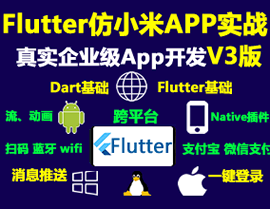Flutter天气预报插件minh_weather_app的使用
Flutter天气预报插件minh_weather_app的使用
本文将介绍如何在Flutter项目中使用minh_weather_app插件来实现天气预报功能。通过简单的步骤和完整的代码示例,您将能够快速上手并集成天气预报功能到您的Flutter应用中。
使用步骤
1. 创建一个新的Flutter项目
首先,确保您已经安装了Flutter开发环境,并创建一个新的Flutter项目。
flutter create weather_app
cd weather_app2. 添加依赖
在pubspec.yaml文件中添加minh_weather_app依赖。
dependencies:
flutter:
sdk: flutter
minh_weather_app: ^0.1.0 # 替换为最新版本号然后运行以下命令以获取依赖:
flutter pub get3. 初始化天气插件
在main.dart文件中初始化天气插件,并设置API密钥(如果您有)。
import 'package:flutter/material.dart';
import 'package:minh_weather_app/minh_weather_app.dart';
void main() {
runApp(MyApp());
}
class MyApp extends StatelessWidget {
[@override](/user/override)
Widget build(BuildContext context) {
return MaterialApp(
title: 'Weather App',
theme: ThemeData(
primarySwatch: Colors.blue,
),
home: WeatherScreen(),
);
}
}4. 编写天气屏幕逻辑
创建一个WeatherScreen类来显示天气信息。
class WeatherScreen extends StatefulWidget {
[@override](/user/override)
_WeatherScreenState createState() => _WeatherScreenState();
}
class _WeatherScreenState extends State<WeatherScreen> {
String? _cityName;
String? _temperature;
String? _condition;
Future<void> _fetchWeather(String city) async {
final weather = MinhWeather(city: city);
final data = await weather.fetchWeather();
setState(() {
_cityName = data.cityName;
_temperature = data.temperature.toString();
_condition = data.condition;
});
}
[@override](/user/override)
Widget build(BuildContext context) {
return Scaffold(
appBar: AppBar(
title: Text('天气预报'),
),
body: Center(
child: Column(
mainAxisAlignment: MainAxisAlignment.center,
children: [
ElevatedButton(
onPressed: () {
_fetchWeather('London'); // 可以替换为您想要的城市
},
child: Text('获取天气'),
),
SizedBox(height: 20),
Text(_cityName ?? '未选择城市'),
Text(_temperature ?? '加载中...'),
Text(_condition ?? '加载中...'),
],
),
),
);
}
}更多关于Flutter天气预报插件minh_weather_app的使用的实战系列教程也可以访问 https://www.itying.com/category-92-b0.html
minh_weather_app 是一个用于 Flutter 的天气预报插件,它可以帮助你轻松地在应用中集成天气预报功能。以下是如何使用 minh_weather_app 插件的基本步骤:
1. 添加依赖
首先,你需要在 pubspec.yaml 文件中添加 minh_weather_app 插件的依赖。
dependencies:
flutter:
sdk: flutter
minh_weather_app: ^1.0.0 # 请使用最新版本然后运行 flutter pub get 来获取依赖。
2. 获取 API Key
minh_weather_app 插件通常需要与某个天气 API 服务(如 OpenWeatherMap)进行交互。你需要注册并获取一个 API Key。
3. 初始化插件
在你的 Dart 文件中导入插件并初始化它。
import 'package:minh_weather_app/minh_weather_app.dart';
void main() {
MinhWeatherApp.initialize(apiKey: 'YOUR_API_KEY');
runApp(MyApp());
}4. 获取天气数据
你可以使用 MinhWeatherApp 提供的方法来获取天气数据。例如,获取当前天气:
Future<void> fetchWeather() async {
try {
WeatherData weatherData = await MinhWeatherApp.getCurrentWeather(cityName: 'Hanoi');
print('Temperature: ${weatherData.temperature}°C');
print('Weather Condition: ${weatherData.condition}');
} catch (e) {
print('Failed to fetch weather data: $e');
}
}5. 显示天气数据
你可以将获取到的天气数据显示在 UI 中。例如,使用 Text 组件显示温度和天气状况:
class WeatherScreen extends StatefulWidget {
@override
_WeatherScreenState createState() => _WeatherScreenState();
}
class _WeatherScreenState extends State<WeatherScreen> {
WeatherData? _weatherData;
@override
void initState() {
super.initState();
fetchWeather();
}
Future<void> fetchWeather() async {
try {
WeatherData weatherData = await MinhWeatherApp.getCurrentWeather(cityName: 'Hanoi');
setState(() {
_weatherData = weatherData;
});
} catch (e) {
print('Failed to fetch weather data: $e');
}
}
@override
Widget build(BuildContext context) {
return Scaffold(
appBar: AppBar(
title: Text('Weather App'),
),
body: Center(
child: _weatherData == null
? CircularProgressIndicator()
: Column(
mainAxisAlignment: MainAxisAlignment.center,
children: [
Text('Temperature: ${_weatherData!.temperature}°C'),
Text('Condition: ${_weatherData!.condition}'),
],
),
),
);
}
}6. 处理错误
在实际应用中,你需要处理可能出现的错误,例如网络问题或无效的 API Key。你可以使用 try-catch 块来捕获异常并显示错误信息。
7. 其他功能
minh_weather_app 插件可能还提供了其他功能,例如获取未来几天的天气预报、获取天气图标等。你可以查阅插件的文档以了解更多详细信息。
8. 运行应用
完成上述步骤后,你可以运行你的 Flutter 应用,查看天气预报功能是否正常工作。
flutter run






